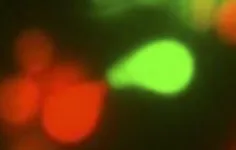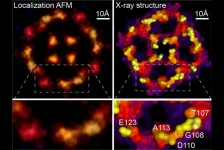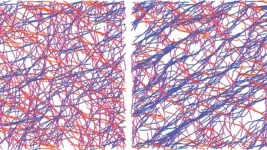Yeast mating -- more than meets the eye
Pheromones mediate asymmetric mating behavior in isogamous yeast
2021-06-16
(Press-News.org) Researchers from the Max-Planck Institute for Terrestrial Microbiology have discovered a surprising asymmetry in the mating behavior of unicellular yeast that emerges solely from molecular differences in pheromone signaling. Their results, published in the current issue of "Science Advances", might shed new light on the evolutionary origins of sexual dimorphism in higher eukaryotes.
Resemblant of higher organisms, yeast gametes communicate during the mating process by secreting and sensing sexual pheromones. However, in contrast to higher eukaryotes, budding yeast is isogamous: seen through a microscope, gametes of both mating types ("sexes"), MATa and MATα, look exactly the same. Since anisogamy -- difference in size between male and female gametes --was considered to be the starting point of sexual selection that drives the evolution of differences in sexual behavior, mating types of S. cerevisiae were assumed to be not only morphologically but also behaviorally symmetric.
Now a research team led by Victor Sourjik from the Max-Planck Institute for Terrestrial Microbiology and his former postdoctoral fellow Alvaro Banderas, now at the Institut Curie in Paris, has discovered a hidden behavioral asymmetry that emerges solely from molecular differences in pheromone signaling between the two mating types, which might have wide-reaching implications for understanding evolution of sexual dimorphism in higher organisms.
Yeast mating involves a- and α-pheromones that trigger the interactions between the two different types, MATa and MATα. Although the pheromones and their respective receptors are chemically different, the remainder of the pheromone response pathway (one of the best-studied models for eukaryotic signal transduction) is the same for both mating types. It was therefore thought that in yeast, as well as in other isogamous eukaryotic microorganisms, molecular differences between the a- and α-pheromones and their receptors are only required in order to ensure self-incompatibility between the two mating types but have no further functional consequences.
"As a matter of fact, our original intention was to confirm that the behavior of both mating types is similar. Yet, to our surprise, we found it to be strikingly different", says Alexander Anders, first author of the manuscript.
Remarkably, the observed differences, with MATa cells exhibiting exploratory search behavior and MATα cells showing short-range gradient sensing and polarization towards the proximal mate, resemble well-established asymmetries between gametes in anisogamous organisms. "It turns out that behavioral asymmetry of the gametes is not necessarily a consequence of anisogamy, but could actually have preceded it - this challenges the previous assumptions on evolution by sexual selection as the sole generative mechanism of differences in mating behavior between sexes", says Alvaro Banderas, the co-corresponding author of the manuscript.
Importantly, mathematical modeling and computer simulations suggest that such asymmetric behavior might provide selective fitness advantage by enhancing efficiency of mating over a wide range of environments. "Behavioral asymmetry could maximize frequency of mating encounters under different conditions, meaning that it might be an evolutionary selected emergent property", says Remy Colin, who performed mathematical modeling.
What do these findings tell us about the origins of sexual behavior? "Although further theoretical analysis is clearly required to test our hypothesis", emphasizes Victor Sourjik, "our work on mating of a model unicellular eukaryote provides a new perspective on what might have been the starting point for the evolution of the amazing diversity of sexual dimorphisms observed today".
INFORMATION:
Original publication
Anders, A.; Colin, R.; Banderas, A; Sourjik, V.
Asymmetric mating behavior of isogamous budding yeast.
Science Advances 7, eabf8404 (2021)
Published 11 Jun 2021
[Attachments] See images for this press release:

ELSE PRESS RELEASES FROM THIS DATE:
2021-06-16
HOUSTON ? The University of Texas MD Anderson Cancer Center's Research Highlights provides a glimpse into recently published studies in basic, translational and clinical cancer research from MD Anderson experts. Current advances include a new combination therapy for acute myeloid leukemia (AML), a greater understanding of persistent conditions after AML remission, the discovery of a universal biomarker for exosomes, the identification of a tumor suppressor gene in hepatocellular carcinoma (HCC) and characterization of a new target to treat Clostridioides difficile (C. difficile) infections.
Utilizing combination therapy for AML
While a majority of patients with acute myeloid leukemia (AML) respond favorably ...
2021-06-16
Scientists at Weill Cornell Medicine have developed a computational technique that greatly increases the resolution of atomic force microscopy, a specialized type of microscope that "feels" the atoms at a surface. The method reveals atomic-level details on proteins and other biological structures under normal physiological conditions, opening a new window on cell biology, virology and other microscopic processes.
In a study, published June 16 in Nature, the investigators describe the new technique, which is based on a strategy used to improve resolution in light microscopy.
To study proteins and other biomolecules at high resolution, investigators have long relied on two techniques: X-ray crystallography ...
2021-06-16
A new rubber band stretches, but then snaps back into its original shape and size. Stretched again, it does the same. But what if the rubber band was made of a material that remembered how it had been stretched? Just as our bones strengthen in response to impact, medical implants or prosthetics composed of such a material could adjust to environmental pressures such as those encountered in strenuous exercise.
A research team at the University of Chicago is now exploring the properties of a material found in cells which allows cells to remember and respond to environmental pressure. In a paper published on May 14, 2021 in Soft Matter, they teased ...
2021-06-16
PHILADELPHIA - Amyotrophic lateral sclerosis (ALS), also known as Lou Gehrig's disease, is a neurodegenerative disease that strikes nearly 5,000 people in the U.S. every year. About 10% of ALS cases are inherited or familial, often caused by an error in the C9orf72 gene. Compared to sporadic or non-familial ALS, C90rf72 patients are considered to have a more aggressive disease course. Evidence points to the immune system in disease progression in C90rf72 patients, but we know little of what players are involved. New research from the Jefferson Weinberg ALS Center identified an increased ...
2021-06-16
While crop yield has achieved a substantial boost from nanotechnology in recent years, alarms over the health risks posed by nanoparticles within fresh produce and grains have also increased. In particular, nanoparticles entering the soil through irrigation, fertilizers and other sources have raised concerns about whether plants absorb these minute particles enough to cause toxicity.
In a new study published online in the journal END ...
2021-06-16
Although each organism has a unique genome, a single gene sequence, each individual has many epigenomes. An epigenome consists of chemical compounds and proteins that can bind to DNA and regulate gene action, either by activating or deactivating them or producing organ- or tissue-specific proteins. As it is a highly dynamic material, it can provide a large amount of information to shed light on the evolution of the various tissues and organs that make up the body.
Now, a team from the Institute of Evolutionary Biology (IBE), a joint centre of the Spanish National Research Council (CSIC) and Pompeu Fabra University, has carried out the largest study to date on the regulatory ...
2021-06-16
By repurposing common ingredients in hair conditioner, scientists have designed an inexpensive, transparent coating that can turn surfaces like windows and ceilings into glue pads to trap airborne aerosol droplets. This new strategy is described June 16 in the journal Chem.
"Facing a pandemic, we need to proactively leverage all of the different layers of defense mechanisms, including the physical barriers," says corresponding author Jiaxing Huang, a professor of materials science and engineering at Northwestern University. "After all, these viruses must travel through physical space before reaching and eventually infecting people."
The ...
2021-06-16
Small modeling errors may accumulate faster than previously expected when physicists combine multiple gravitational wave events (such as colliding black holes) to test Albert Einstein's theory of general relativity, suggest researchers at the University of Birmingham in the United Kingdom. The findings, published June 16 in the journal iScience, suggest that catalogs with as few as 10 to 30 events with a signal-to-background noise ratio of 20 (which is typical for events used in this type of test) could provide misleading deviations from general relativity, erroneously pointing to new physics where none exists. Because this is close to the size of current catalogs used to assess Einstein's ...
2021-06-16
Human babies do even more than we thought while sleeping.
A new study from University of Iowa researchers provides further insights into the coordination that takes place between infants' brains and bodies as they sleep.
The Iowa researchers have for years studied infants' twitching movements during REM sleep and how those twitches contribute to babies' ability to coordinate their bodily movements. In this study, the scientists report that beginning around three months of age, infants see a pronounced increase in twitching during a second major stage of sleep, called quiet sleep.
"This was completely surprising and, for all we know, ...
2021-06-16
When Betelgeuse, a bright orange star in the constellation of Orion, lost more than two-thirds of its brightness in late 2019 and early 2020, astronomers were puzzled.
What could cause such an abrupt dimming?
Now, in a new paper published Wednesday in Nature, an international team of astronomers reveal two never-before-seen images of the mysterious darkening --and an explanation. The dimming was caused by a dusty veil shading the star, which resulted from a drop in temperature on Betelgeuse's stellar surface.
Led by Miguel Montargès at the Observatoire de Paris, the new images were taken in January and March of 2020 using the European Southern Observatory's Very Large Telescope. Combined with images previously taken in ...
LAST 30 PRESS RELEASES:
[Press-News.org] Yeast mating -- more than meets the eye
Pheromones mediate asymmetric mating behavior in isogamous yeast


